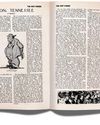Essayer OR - Gratuit
ACID REFLUX
The New Yorker
|January 29, 2024
When America first went tripping.

One evening in September of 1957, viewers across America could turn on their television sets and tune in to a CBS broadcast during which a young woman dropped acid. She sat next to a man in a suit: Sidney Cohen, the researcher who had given her the LSD. The woman wore lipstick and nail polish, and her eyes were shining. "I wish I could talk in Technicolor," she said. And, at another point, "I can see the molecules. I... I'm part of it. Can't you see it?" "I'm trying," Cohen replied.
Were some families maybe-oh, I don't know-eating meat loaf on TV trays as they watched this nice lady undergo her mind-bending, molecule-revealing journey through inner space? Did they switch to "Father Knows Best" or "The Perry Como Show" afterward? One of the feats that the historian Benjamin Breen pulls off in his lively and engrossing new book, "Tripping on Utopia: Margaret Mead, the Cold War, and the Troubled Birth of Psychedelic Science" (Grand Central), is to make a cultural moment like the anonymous woman's televised trip seem less incongruous, if no less fascinating.
In Breen's telling, the buttoned-down nineteen-fifties, not the freewheeling nineteen-sixties, brought together the ingredients, some of them toxic, for the first large-scale cultural experiment with consciousness-expanding substances.
The psychedelic flowering of the sixties has, it turns out, a prequel-a rich and partly forgotten chapter before the hippie movement, before the shamanistic preening and posturing of Timothy Leary, and before the war on drugs shut all that down. This earlier history encompasses not only the now notorious C.I.A. research into mind-altering drugs but also a lighter, brighter, more public dimension of better living through chemistry, buoyed by postwar scientific optimism and public reverence for expertise. "Timothy Leary and the Baby Boomers did not usher in the first psychedelic era," Breen writes.
Cette histoire est tirée de l'édition January 29, 2024 de The New Yorker.
Abonnez-vous à Magzter GOLD pour accéder à des milliers d'histoires premium sélectionnées et à plus de 9 000 magazines et journaux.
Déjà abonné ? Se connecter
PLUS D'HISTOIRES DE The New Yorker

The New Yorker
FORTRESS OF SYNERGY
\"Superman.\"
6 mins
July 21, 2025

The New Yorker
THE NEXT WAR
Is the U.S. ready for the future of combat?
39 mins
July 21, 2025

The New Yorker
ESCAPE ROUTE
Geoff Dyer tracks the comic confusions of a working-class British upbringing.
12 mins
July 21, 2025

The New Yorker
Paige Williams on Marquis James's Preview of the Scopes Monkey Trial
One of the first New Yorker writers hired by Harold Ross, the founding editor, was Marquis James. The men were good friends whose wives were also good friends; the couples vacationed together. James's début feature ran in the second issue, in February, 1925. I could have written this piece about that piece, a Profile of Alice Roosevelt Longworth, a child of Theodore Roosevelt, based on the following passage alone: “She knows men, measures and motives; has an understanding grasp of their changes. That's all there is to what is grandiosely known as ‘public affairs.”
2 mins
July 21, 2025

The New Yorker
BAGGAGE CHECK
“Too Much,” on Netflix.
5 mins
July 21, 2025

The New Yorker
LOSING LONELINESS
In the age of A.I., you never have to feel lonely again. That's not necessarily a good thing.
15 mins
July 21, 2025

The New Yorker
JUNK-DRAWER HEART
Ryan Davis's wordy disquisitions on desire.
5 mins
July 21, 2025

The New Yorker
FAMILY PRACTICE
A pediatrician’s search for redemption.
24 mins
July 21, 2025

The New Yorker
NATURAL HISTORY
He walked out of the precinct and wondered immediately what time it was.
22 mins
July 21, 2025

The New Yorker
SERVE AND FOLLY
The annual British yearning for a homegrown Wimbledon champion.
22 mins
July 21, 2025
